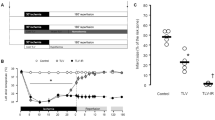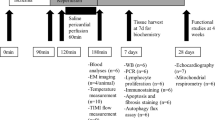Abstract
The aim of the present study was to investigate if hypothermia and rewarming, without accompanying cardiac ischaemia or cardioplegia, causes myocardial damage. Anaesthetized rats were subjected to a cooling procedure (4 h at 15–13°C) where spontaneous cardiac electromechanical activity was maintained, followed by rewarming. Control rats, hypothermic rats and posthypothermic rats were perfusion-fixed, the hearts removed and the ventricles examined using an electron microscope. Based on morphometric methodology volume fractions as well as absolute volumes of cellular and subcellular components of the ventricles were assessed. In hypothermic hearts capillary volume fraction was significantly decreased, which was probably due to a decrease in perfusion pressure. The cytosolic volume increased in both absolute values and as a fraction of the myocyte: from 25 ± 11 in controls to 43 ± 8 μl and from 0.067 ± 0.023 to 0.102 ±0.013, respectively. There was a corresponding relative decrease in the volume fraction of myofilaments from 0.598 ± 0.030 to 0.548 ± 0.024. In posthypothermic hearts significant tissue swelling was apparent, dominated by a significant increase in myocyte volume from 372 ± 66 in controls to 522 ±166 μl. Similar changes were measured in mitochondrial and cytosolic volumes. In conclusion, the myocardial ultrastructure was altered during hypothermia as well as after rewarming. Posthypothermic myocardium showed generalized cellular swelling and areas of cellular necrosis.
Similar content being viewed by others
References
Aoki M, Nomura F, Mayer JE (1994) Interactions between preischemic hypothermia and cardioplegic solutions in the neonatal lamb heart. J Thorac Cardiovasc Surg 107:822–828
Blair E, Montgomery AV, Swan H (1956) Posthypothermic circulatory failure. I. Physiologic observations on the circulation. Circulation 13:909–915
Chen RYZ, Chien S (1977) Plasma volume, red cell volume, and thoracic duct lymph flow in hypothermia. Am J Physiol 233:H605–H612
Chen RYZ, Chien S (1978) Hemodynamic functions and blood viscosity in surface hypothermia. Am J Physiol 235:H136–H143
Endrich B, Hammersen F, Messmer K (1990) Microvascular ultrastructure in non-freezing cold injuries. Res Exp Med 190:365–379
Jennings RB, Reimer KA, Steenbergen C (1986) Myocardial ischemia revisited. The osmolar load, membrane damage, and reperfusion. J Mol Cell Cardiol 18:769–780
Keon WJ, Labow RS, Hendry PJ, Barry YA (1991) The human atrial trabecula: Effects of calcium and temperature. J Mol Cell Cardiol 23:357–364
Kiyosue T, Arita M, Maramatsu H, Spindler AJ, Noble D (1993) Ionic mechanisms of action potential prolongation at low temperature in guinea-pig ventricular myocytes. J Physiol 468:85–106
Labow RS, Hendry PJ, Meek E, Keon J (1993) Temperature affects human cardiac sarcoplasmic reticulum energy-mediated calcium transport. J Mol Cell Cardiol 25: 1161–1170
Lien YH, Zhou H, Job C, Gillies RJ (1993) 31P study of hypothermic effect of intact glioma cells cultured in bioreactors. FASEB J 7: A443
Lyons JM, Raison JK (1970) A temperature-induced transition in mitochondrial oxidation: contrasts between cold and warm-blooded animals. Comp Biochem Physiol 37:405–411
Løfstrøm B (1959) Induced hypothermia and intravascular aggregation. Acta Anaesthesiol Scand 3:1–19
Macknight AD, Leaf A (1977) Regulation of cellular volume. Physiol Rev 57:510–573
Martin DR, Scott DF, Downes GL, Folkert BS, Belzer O (1972) Primary cause of unsuccessful liver and heart preservation: cold sensitivity of the ATPase system. Ann Surg 175:111–117
Martineau Knerr SH, Lieberman M (1993) Ion transport during hypothermia in cultured heart cells: implications for protection of the immature myocardium. J Mol Cell Cardiol 25:277–288
McDowell EM, Trump BF (1976) Histologic fixatives suitable for diagnostic light and electron microscopy. Arch Pathol Lab Med 100:405–414
McMurchie EJ, Raison JK, Cairncross KD (1973) Temperature-induced phase changes in membranes of heart: a contrast between the thermal response of poikilotherms and homotherms. Comp Biochem Physiol 44B:1017–1026
Rebeyka IM, Hanan SA, Borges MR, et al (1990) Rapid cooling contracture of the myocardium: the adverse effect of prearrest cardiac hypothermia. J Thorac Cardiovasc Surg 100:240–249
Sarajas HSS (1964) Myocardial damage induced by immersion hypothermia. Am J Cardiol 13:355–366
Sharper J, Mulch J, Winkler B, Schaper W (1979) Ultrastructural, functional and biochemical criteria for estimation of reversibility of ischemic injury: a study on the effects of global ischemia on the isolated dog heart. J Mol Cell Cardiol 11:521–541
Shattock MJ, Bers DM (1987) Inotropic response to hypothermia and the temperature-dependence of ryanodine action in isolated rabbit and rat ventricular muscle: implications for excitation-contraction coupling. Circ Res 61:761–771
Steen PA, Milde JH, Michenfelder JD (1980) The detrimental effects of prolonged hypothermia and rewarming in the dog. Anesthesiology 52:224–230
Steigen TK, Pettersen S, Guddal PH, Larsen TS (1992) Effects of hypothermia and rewarming on phospholipase C-evoked glycerol output in rat myocardial cells. J Mol Cell Cardiol 24:457–464
Suleiman MS, Rodrigo Glenn C, Chapman RA (1990) Effect of hypothermia on Na influx during the Ca-paradox in guinea-pig ventricular myocytes and isolated ventricular trabeculae of the ferret. J Physiol 427:53P
Tveita T, Skandfer M, Refsum H, Ytrehus K (1996) Experimental hypothermia and rewarming: Changes in mechanical function and metabolism of rat hearts. J Appl Physiol 80:291–297
Tveita T, Ytrehus K, Myklebust R, Refsum H (1991) Changes in myocardial ultrastructure and mechanical performance after rewarming from prolonged hypothermia in rats. J Mol Cell Cardiol 23 (Suppl V): 103
Tveita T, Ytrehus K, Skandfer M, et al (1996) Changes in blood flow distribution and capillary function after deep hypothermia in rat. Can J Physiol Pharmacol 74:376–381
Weibel ER, Bolender RP (1973) Stereological techniques for electron microscopic morphometry. In: Hayat MA (ed) Van Nostrand Reinhold company, New York, Principles and Techniques for Electron Microscopy, vol 3:237–296
Ytrehus K, Gunnes S, Myklebust R, Mjøs OD (1987) Protection by superoxide dismutase and catalase in the isolated rat heart reperfused after prolonged cardioplegia: a combined study of metabolic, functional, and morphometric ultrastructural variables. Cardiovasc Res 21:492–499
Ytrehus K, Myklebust R, Olsen R, Mjøs OD (1987) Ultrastructural changes in the isolated rat heart by enzymatically generated oxygen radicals. J Mol Cell Cardiol 19:379–389
Øksendal AN, Jynge P, Sellevold OFM, Rotevatn S, Sætersdal T (1985) The calcium paradox phenomenon: a flow rate and volume response study of calcium-free perfusion. J Mol Cell Cardiol 17:959–972
Author information
Authors and Affiliations
Rights and permissions
About this article
Cite this article
Tveita, T., Myklebust, R. & Ytrehus, K. Changes in myocardial ultrastructure induced by cooling as well as rewarming. Res. Exp. Med. 197, 243–254 (1997). https://doi.org/10.1007/s004330050073
Received:
Accepted:
Published:
Issue Date:
DOI: https://doi.org/10.1007/s004330050073




